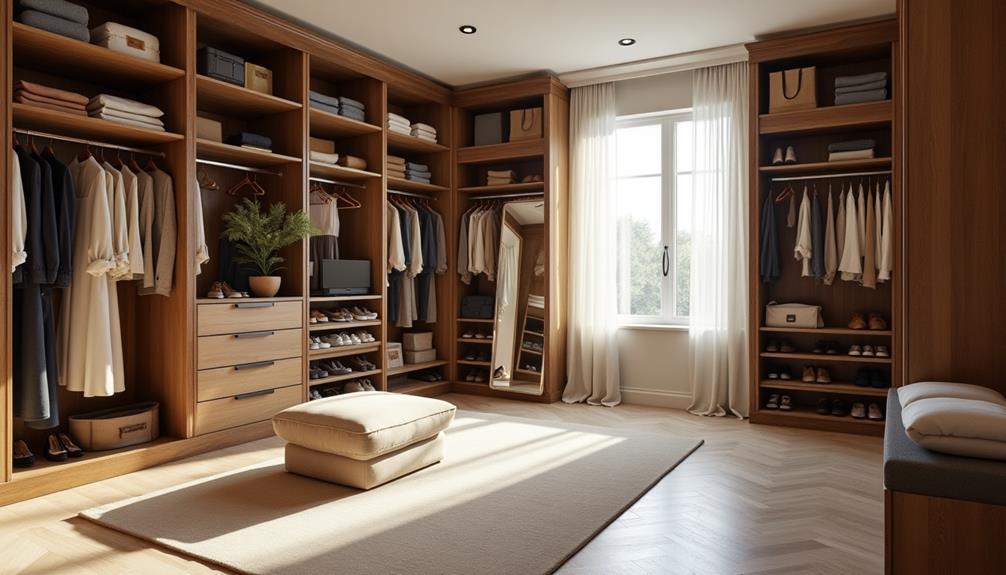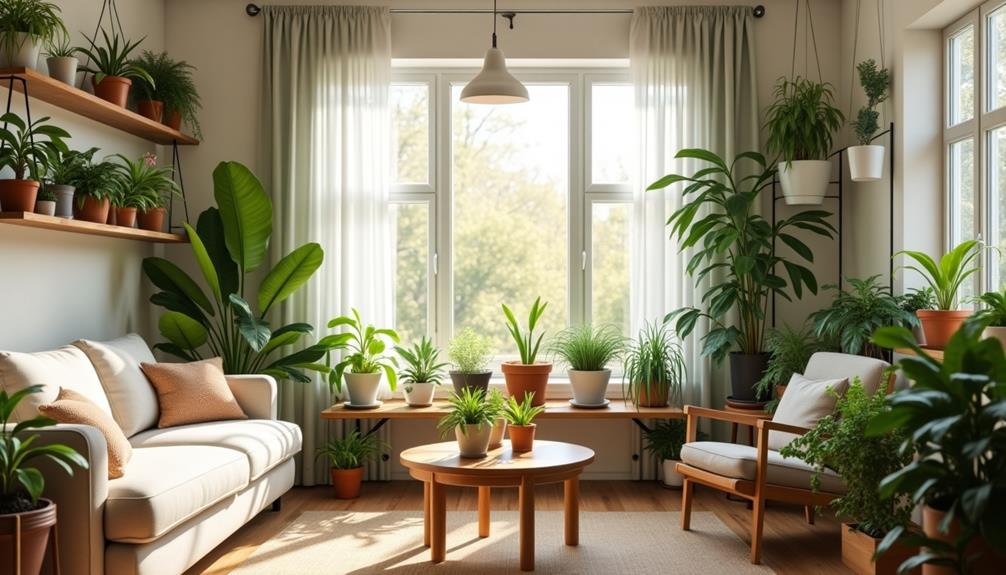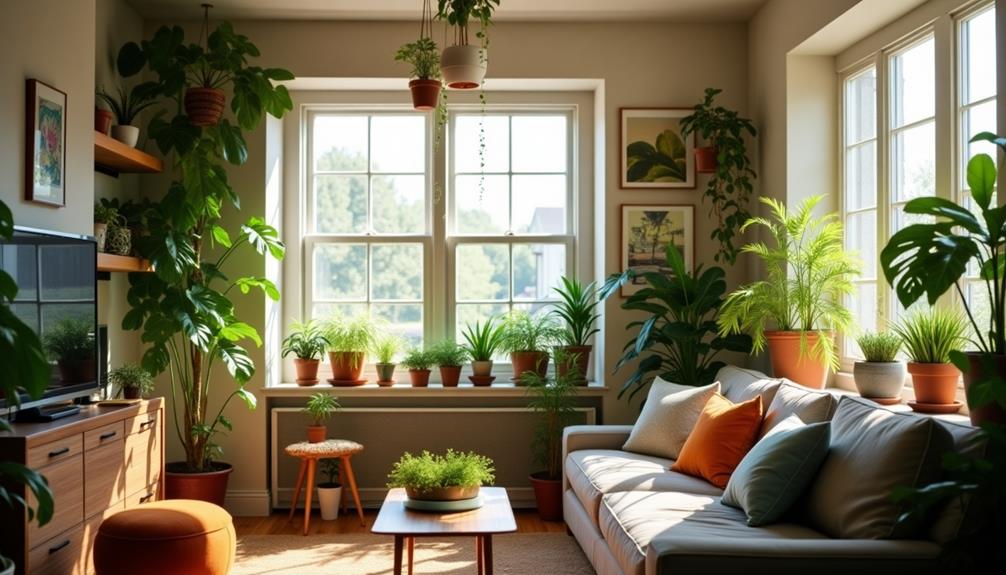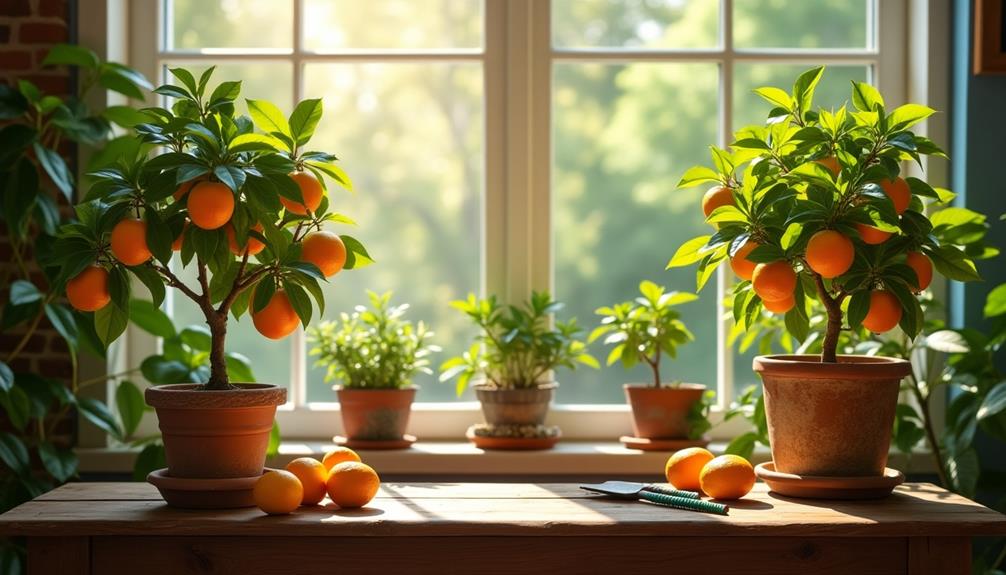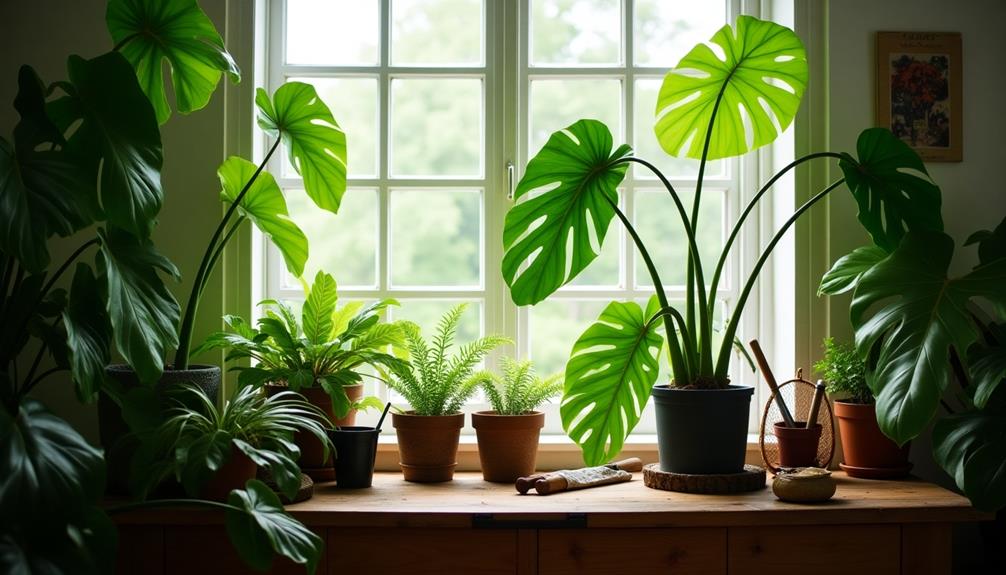When it comes to transforming your space into a personal haven, a walk-in closet can certainly elevate your home's organization. You'll want to start by assessing your available area and considering how best to utilize it. Planning a functional layout is key, but there are nuances that can make all the difference. From selecting the right storage solutions to installing shelves that cater to your wardrobe, each step plays a crucial role. Curious about how to maintain that fresh, organized look once you've built it?
Assessing Your Space
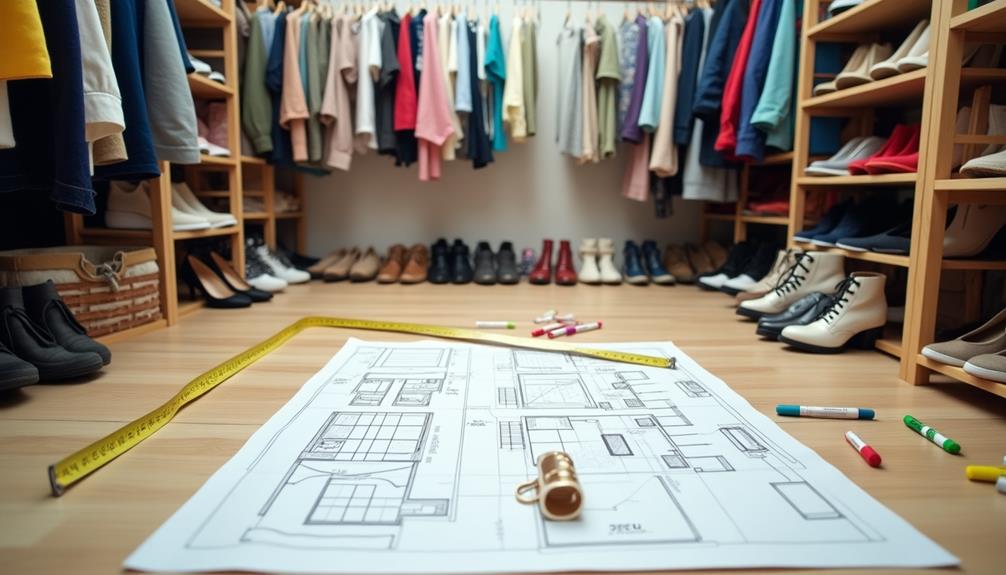
Before diving into your DIY walk-in closet project, it's essential to assess your space effectively. Start by measuring your space dimensions. Get a tape measure and jot down the length, width, and height of your closet area. Knowing these numbers helps you understand how much room you have for shelves, hanging rods, and storage solutions.
Next, consider the natural lighting options available. If your closet has windows, take note of how much light comes in during the day. This can influence your choice of colors and materials, making the space feel more inviting.
If natural light is limited, think about installing additional lighting. You might want to add LED strip lights under shelves or consider a stylish overhead fixture to brighten up the area.
Additionally, evaluate the flow of the space. Make sure you can easily access your clothing and accessories without feeling cramped. Having a clear pathway will enhance the functionality of your walk-in closet.
Planning Your Layout
Planning the layout of your walk-in closet is a crucial step that can make or break its functionality. Start by measuring your space accurately, keeping in mind door swings and any built-in features. Once you've got your dimensions, sketch a basic layout design that reflects your needs.
Think about how you want to organize your items—do you need more hanging space, shelving, or drawers?
Consider the concept of space optimization. You want to maximize every inch of your closet while ensuring easy access to your belongings. Arrange your layout to create distinct zones: one for clothes, another for shoes, and perhaps a section for accessories. This zoning helps you visualize where everything will go and keeps your closet organized.
Also, think about the flow of movement within the space. You should be able to reach items without having to shuffle around too much.
Incorporating vertical storage solutions can also help maximize your layout, allowing for more items without crowding the floor.
Choosing Storage Solutions

When it comes to choosing storage solutions for your walk-in closet, you have a wealth of options that can cater to your specific needs.
Start by considering shelving options; adjustable shelves allow you to customize the height for different items. Incorporate closet organizers to maximize your space efficiently, keeping everything within easy reach.
Hanging systems are essential for clothes and can be tailored to accommodate various types of garments. Pair these with drawer dividers to keep your smaller items, like socks and underwear, neatly arranged.
If you have a shoe collection, shoe racks can help you display them while keeping them organized.
Don't forget about storage bins; they're perfect for seasonal items or accessories you don't use daily. Accessory trays can also be a great addition, helping you to store jewelry and other small items in an organized manner.
By combining these elements, you can create a functional and stylish walk-in closet that meets your needs.
Selecting Materials
Choosing the right materials for your walk-in closet can significantly enhance both its functionality and aesthetic appeal. Start by exploring various material types that suit your style and needs. For shelving and storage solutions, consider options like plywood, MDF, or solid wood. Plywood is sturdy and cost-effective, while solid wood offers a luxurious finish. If you're aiming for a modern look, metal shelving might be the way to go.
Next, think about the finishes. Paint can add a pop of color, while laminate surfaces offer a sleek, easy-to-clean option. Don't forget about hardware—selecting handles and knobs in materials like brushed nickel or brass can elevate your closet's overall design.
Budget considerations are crucial at this stage. Determine how much you're willing to spend on materials, and keep an eye out for sales or discounts. You can often find quality materials that won't break the bank.
Gathering Tools and Supplies
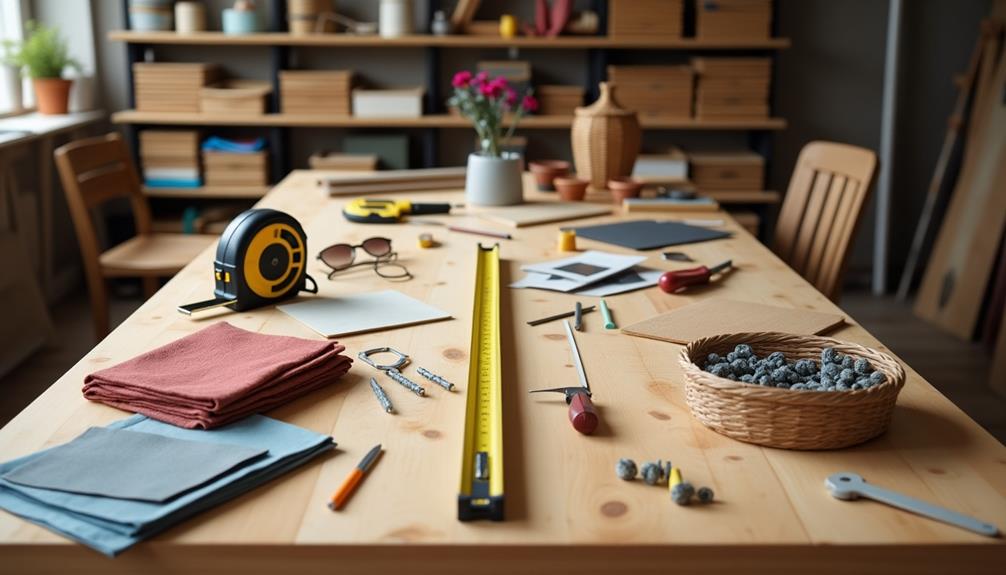
Before diving into your DIY walk-in closet project, gathering the right tools and supplies is essential for a smooth and successful build. Start by creating a list of the tools you'll need, such as a tape measure, level, drill, saw, and screwdrivers.
Don't forget safety glasses and gloves to protect yourself while working.
Next, consider your supplies. Depending on your design, you'll need shelving, brackets, and rods for hanging clothes. Make sure to measure your space accurately to avoid any costly mistakes.
When it comes to budgeting tips, set a clear budget before heading to the store. Research prices online and compare materials to find affordable options that fit your style.
It's also wise to factor in extra costs for tools you mightn't own, like a stud finder or a miter saw.
Lastly, don't overlook safety precautions. Ensure your workspace is well-lit and free from clutter. If you're using power tools, familiarize yourself with their operation to prevent accidents.
With the right tools and supplies, you'll be well on your way to creating that dream walk-in closet!
Installing Shelving Units
With your tools and supplies ready, it's time to start installing your shelving units. First, decide on the shelving styles that suit your space and needs. Options include adjustable shelves, fixed shelves, or cube systems. Each has its own aesthetic and functional benefits, so choose wisely.
Next, measure the wall space where you'll install the units. Mark the desired heights for your shelves using a level to ensure they're straight. Remember to consider the weight capacity of the shelves you select. This is crucial, especially if you plan to store heavier items like shoes or boxes.
Using a stud finder, locate the wall studs and mark them. Attach brackets or wall anchors at the marked points, ensuring they align with the studs for maximum stability. If you're installing adjustable shelving, follow the manufacturer's instructions for mounting the standards.
Once everything's secured, place your shelves on the brackets or standards. Double-check that they're level and secure.
Organizing Your Wardrobe
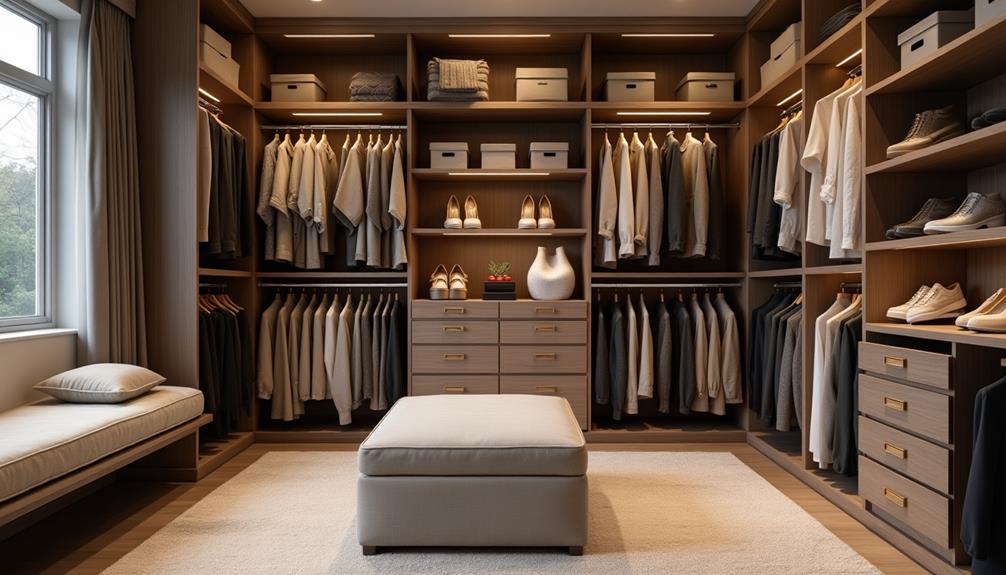
When it comes to organizing your wardrobe, the key lies in creating a system that works for you. Start by decluttering your clothes; donate or discard items you haven't worn in the last year.
Once you have a curated selection, think about wardrobe rotation. Place seasonal items at the forefront, so you can easily access what you need. For instance, keep summer clothes accessible during warmer months and store winter wear in bins or boxes.
Next, utilize seasonal storage to maximize space. Use clear bins for off-season clothing, labeling each one clearly to avoid confusion. This way, you'll maintain a streamlined look in your closet while keeping everything organized.
Consider grouping similar items together—like shirts, pants, and dresses—so you can effortlessly find what you're looking for. You might also want to organize by color to create a visually appealing arrangement.
Lastly, invest in matching hangers and storage solutions to enhance the overall aesthetic of your wardrobe. With these strategies, your walk-in closet won't only be functional but also a joy to navigate every day.
Adding Finishing Touches
After you've organized your wardrobe, it's time to add those finishing touches that elevate the entire space. Start by incorporating decorative accents that reflect your personality. Consider adding a stylish rug to bring warmth and texture underfoot. You might also hang framed art or a mirror to create a focal point and make the area feel larger.
Next, focus on lighting enhancements. Replace standard bulbs with warm, inviting lights that make the closet feel more welcoming. Installing adjustable LED strip lights inside shelves or under hanging rods can add a modern touch and help you find items easily.
If you have the space, a chic chandelier or pendant light can also serve as a statement piece.
Don't forget about storage solutions that double as décor. Woven baskets or decorative boxes can keep smaller items organized while adding visual interest.
Maintaining Your Closet
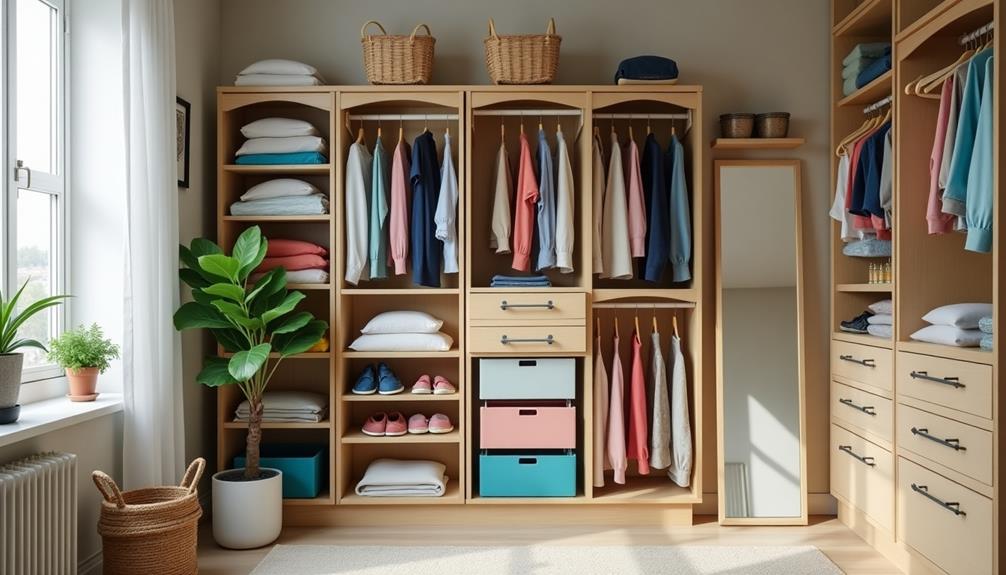
Consistency is key to maintaining your walk-in closet's organized and stylish appeal. To keep everything in check, schedule regular closet cleaning sessions—at least once every few months.
Start by decluttering. Go through your items and remove anything you no longer wear or need. Donate or toss these items to create space.
Next, implement a seasonal rotation for your clothing. As the seasons change, swap out winter clothes for summer ones and vice versa. This not only saves space but also keeps your wardrobe relevant to the current weather. Use storage bins or vacuum-sealed bags to stow away out-of-season items neatly.
Additionally, take a moment to assess your closet's layout. Ensure that everything has a designated spot, from shoes to accessories. Use dividers and labels where necessary to maintain order.

